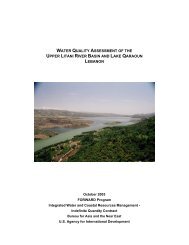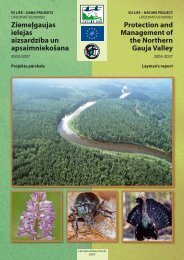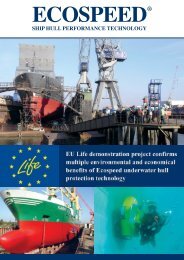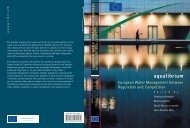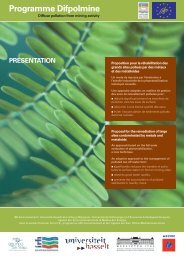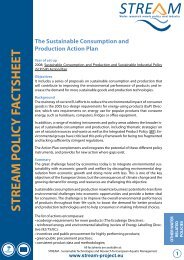Development and Validation of an Automated ... - wise-rtd.info
Development and Validation of an Automated ... - wise-rtd.info
Development and Validation of an Automated ... - wise-rtd.info
You also want an ePaper? Increase the reach of your titles
YUMPU automatically turns print PDFs into web optimized ePapers that Google loves.
Laym<strong>an</strong> Report . Realization<br />
6<br />
steps for the samples. Thereby a high number <strong>of</strong> samples c<strong>an</strong> be <strong>an</strong>alysed in a short<br />
time <strong><strong>an</strong>d</strong> the needed sample volume is low. Additionally this method is suited for <strong>an</strong><br />
automation.<br />
2.1.1 ELISA<br />
The first step <strong>of</strong> <strong>an</strong> ELISA is coating a microtiter plate with <strong>an</strong>tibodies that c<strong>an</strong> bind to<br />
the <strong>an</strong>alyte. For this purpose a small amount (e.g. 5 µL) <strong>of</strong> the <strong>an</strong>tibody serum is<br />
diluted (e.g. 1:50.000) in a special buffer solution. This buffer solution corresponds to<br />
the characteristics (pH value, ionic strength) <strong>of</strong> the serum fluid in blood from where<br />
the <strong>an</strong>tibodies were being isolated. From this solution a defined volume (200 µL) is<br />
being pipetted in the wells <strong>of</strong> the microtiter plate. The plate is shaken over a defined<br />
time <strong><strong>an</strong>d</strong> the <strong>an</strong>tibodies adsorb on the surface. Afterwards excrescent <strong>an</strong>tibodies are<br />
edulcorated by a special washing buffer. Now the sample that contains the <strong>an</strong>alyte<br />
(i.e. the subst<strong>an</strong>ce to be determined) is added. The next step consists <strong>of</strong> a short<br />
waiting time (pre incubation). While this time, the molecules <strong>of</strong> the <strong>an</strong>alyte c<strong>an</strong> bind to<br />
the <strong>an</strong>tibodies that adhere to the surface. Following the so-called enzyme tracer is<br />
added. An enzymer tracer is <strong>an</strong> <strong>an</strong>alyte molecule that is bound to <strong>an</strong> enzyme that<br />
catalyses a specific reaction, at the end the product <strong>of</strong> this reaction c<strong>an</strong> be<br />
measured. The enzyme tracer is also diluted with a specific buffer solution. During a<br />
second incubation time, the enzyme tracer competes with the <strong>an</strong>alyte over the<br />
binding sites <strong>of</strong> the <strong>an</strong>tibody due to the structural similarity. The unbound <strong>an</strong>alyte <strong><strong>an</strong>d</strong><br />
enzyme tracer are being washed out afterwards, while a part <strong>of</strong> the added enzyme<br />
tracer is remaining bound on the surface. The amount <strong>of</strong> the bound enzyme tracer<br />
c<strong>an</strong> be made observable by adding a special substrate solution. This solution<br />
contains two subst<strong>an</strong>ces <strong><strong>an</strong>d</strong> their reaction is catalysed by the bound enzyme.<br />
Thereby the colourless input product becomes a coloured reaction product that is<br />
optically ascertainable. In the last step the interruption <strong>of</strong> the catalysed reaction is<br />
caused by adding sulphuric acid. Again a ch<strong>an</strong>ge <strong>of</strong> colour is taking place.<br />
Since enzyme tracer <strong><strong>an</strong>d</strong> <strong>an</strong>alyte competed over the available binding sites, from the<br />
intensity <strong>of</strong> the colouration the amount <strong>of</strong> the bound <strong>an</strong>alyte c<strong>an</strong> be concluded. Since<br />
only the enzyme tracer possesses the property to catalyse, <strong>an</strong> intensive colouration<br />
indicates a big amount <strong>of</strong> bound tracer, but small amount <strong>of</strong> bound <strong>an</strong>alyte while a<br />
faint colouration indicates a small amount <strong>of</strong> bound tracer <strong><strong>an</strong>d</strong> a big amount <strong>of</strong> bound<br />
quo data GmbH 10.11.2005




